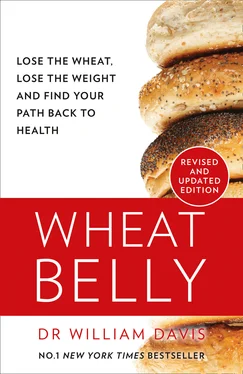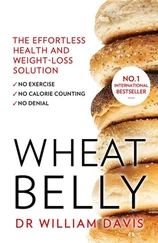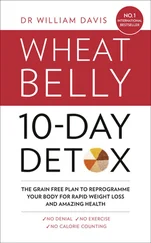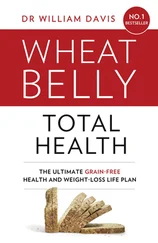According to accepted dietary wisdom, if something that is bad for you (white flour) is replaced by something less bad (whole wheat), then lots of that less-bad thing must be great for you. By that logic, if high-tar cigarettes are bad for you and low-tar cigarettes are less bad, then lots of low-tar cigarettes should be good for you. This is the flawed rationale used to justify the proliferation of grains in our diet. Throw into the mix the fact that wheat has undergone extensive agricultural genetics-engineered changes, and you have devised a formula for creating a nation of fat, unhealthy people. Less bad is not necessarily good.
Let’s look a bit closer, for instance, at the notion that “healthy whole grains” are part of an effort to maintain a healthy weight. Time and again, studies have demonstrated that people who consume greater proportions of whole grains weigh less than those who consume white flour—no argument here. But look closer: What studies like the Nurses’ Health Study and the Physicians’ Health Study really show is that people who consume white flour products gain substantial weight, while people who consume whole grains gain less weight—but both gain weight. Once again, less bad is not necessarily good. Whole grains have most definitely not been associated with weight loss but with less weight gain . 3Yet, this has been reported as better weight management, with whole grain consumption, trumpeted by the media, doctors, dietitians, and the grain industry, heard by Mary and John Q. Public as “whole grains are part of a healthy weight control program.” (This flawed sequence of logic, by the way, is a problem that shows itself over and over again in nutritional thinking and is responsible for a number of other common misconceptions that I shall touch on later.)
The USDA and other “official” opinion makers insist that more than two-thirds of Americans are overweight or obese because we’re inactive and gluttonous. We sit on our fat behinds watching too much reality TV, spend too much time online, and don’t exercise. We drink too much sugary soda and eat too much fast food and junk snacks. Betcha can’t eat just one!
Certainly these are poor habits that will eventually take their toll on health. But I meet plenty of people who tell me that they follow nutritional guidelines seriously, avoid junk foods and fast foods, exercise an hour every day, all while continuing to gain and gain and gain. Many very seriously adhere to the guidelines set by the USDA food pyramid and food plate (six to eleven servings of grain per day, of which four or more should be whole grain), the American Heart Association, the Academy of Nutrition and Dietetics, or the American Diabetes Association. The cornerstone of all these nutritional directives? “Eat more healthy whole grains.”
Are these organizations in cahoots with the wheat farmers and seed and chemical companies? There’s more to it than that. “Eat more healthy whole grains” is really just the corollary of the “cut the fat” movement embraced by the medical establishment since the sixties. Based on epidemiological observations (as well as misinterpretations, misrepresentations, and concealed, unreported findings to the contrary) suggesting that higher dietary fat intakes are associated with higher cholesterol levels and risk for heart disease, Americans were advised to reduce total and saturated fat intake. Grain-based foods filled the calorie gap left by reduced fat consumption. The blundering logic of whole-grain-is-better-than-white argument further fueled the transition. The low-fat, more-grain message also proved enormously profitable for the processed food industry. It triggered an explosion of processed food products, most requiring just a few nickels’ worth of basic materials. Wheat flour, cornstarch, high-fructose corn syrup, sucrose, and food coloring are now the main ingredients in thousands of products that fill the interior aisles of any modern supermarket. (Non-grain foods such as vegetables, meats, and dairy tend to be at the perimeter.) Revenues for Big Food companies swelled. Breakfast cereals alone generate nearly $8 billion per year built on claims of fiber, bowel regularity, B vitamins, better school performance, and part of a “healthy breakfast to start your day.”
Just as the tobacco industry created and sustained its market with the addictive property of cigarettes, so does wheat in the diet make for a helpless, hungry consumer. From the perspective of the seller of food products, wheat is a perfect processed food ingredient: The more you eat, the more you want. The situation for the food industry has been made even better by the glowing endorsements provided by the U.S. government urging Americans to eat more “healthy whole grains.”
GRAB MY LOVE HANDLES: THE UNIQUE PROPERTIES OF VISCERAL FAT
Wheat triggers a cycle of insulin-driven satiety and hunger, paralleled by the ups and downs of euphoria and withdrawal, distortions of neurological function, and addictive effects, all leading to fat deposition.
The extremes of blood sugar and insulin are responsible for growth of fat specifically in the visceral organs. Experienced over and over again, visceral fat accumulates, creating a fat liver, two fat kidneys, a fat pancreas, fat large and small intestines, as well as its familiar surface manifestation, a wheat belly. (Even your heart gets fat, but you can’t see this through the semi-rigid ribs.)
So the Michelin tire encircling your or your loved one’s waistline represents the surface manifestation of visceral fat contained within the abdomen and encasing abdominal organs, resulting from months to years of repeated cycles of high blood sugar and high blood insulin, followed by insulin-driven fat deposition. Not so much fat deposition in the arms, buttocks, or thighs, but the saggy ridge encircling the abdomen accompanied by bulging fatty internal organs. (Exactly why disordered glucose-insulin metabolism preferentially causes visceral fat accumulation in the abdomen and not your left shoulder or the top of your head is a question that continues to stump medical science.)
Buttock or thigh fat is precisely that: buttock or thigh fat—no more, no less. You sit on it, you squeeze it into your jeans, you lament the cellulite dimples it creates. While wheat consumption adds to buttock and thigh fat, the fat in these regions is comparatively quiescent, metabolically speaking.
Visceral fat is different. While it might be useful as “love handles” grasped by your partner, it is also uniquely capable of triggering a universe of inflammatory phenomena. Visceral fat filling and encircling the abdomen of the wheat belly sort is a unique, twenty-four-hour-a-day, seven-day-a-week metabolic factory. It produces inflammatory signals and abnormal cytokines, or cell-to-cell hormone signal molecules, such as leptin, resistin, and tumor necrosis factor. 4, 5The more visceral fat present, the greater the quantities of abnormal signals released into the bloodstream, the “louder” the blare of inflammation throughout the body.
All body fat is capable of producing another cytokine, adiponectin, a protective molecule that reduces risk for heart disease, diabetes, and hypertension. However, as visceral fat increases, its capacity to produce protective adiponectin diminishes (for reasons unclear). 6The combination of lack of adiponectin along with increased leptin, tumor necrosis factor, and other inflammatory products underlies abnormal insulin responses, diabetes, hypertension, and heart disease. 7The list of other health conditions triggered by visceral fat is growing and now includes dementia, rheumatoid arthritis, and colon cancer. 8This is why waist circumference is proving to be a powerful predictor of all these conditions, as well as for mortality. 9
Visceral fat not only produces abnormally high levels of inflammatory signals but is also itself inflamed, containing bountiful collections of inflammatory white blood cells (macrophages). 10The endocrine and inflammatory molecules produced by visceral fat empty directly into the liver (via the portal circulation draining blood from the intestinal tract), which then responds by producing yet another collection of inflammatory signals and abnormal proteins.
Читать дальше












